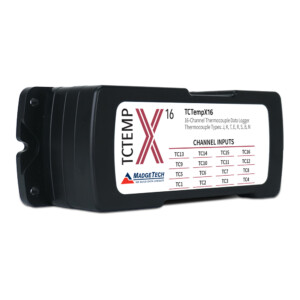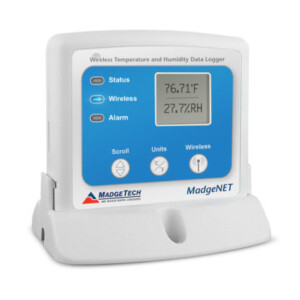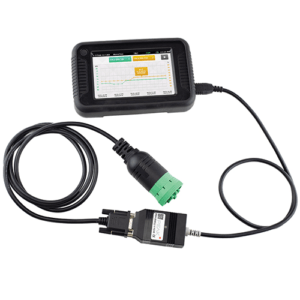For those unfamiliar with the various types of temperature sensors that are available, choosing the most suitable sensor can be a daunting task. To help make this choice easier, below are descriptions of three common types of temperature sensors: Thermocouples, RTDs, and Thermistors.
Thermocouples
When a temperature difference exists between the ends of two dissimilar, electrically conductive materials that have been joined on either end to form a loop, electrons begin to flow from the warmer junction to the cooler junction. This results in a positive electrical charge at the warmer junction, and a negative charge at the cooler junction, creating a voltage. This is known as the Seebeck effect.
Thermocouples take advantage of this effect for the purpose of measuring temperature. A thermocouple is constructed of two different types of metal wire that are joined one each end to form a circuit. When a temperature change occurs at one of the junctions between the wires, the voltage created through the Seebeck effect can be measured to calculate the temperature. Because the voltage from the thermocouple wires will represent a differential temperature, it must be compared to a reference temperature to determine the absolute temperature, in a process known as “cold junction compensation.”
Various combinations of metal wires can be used to create a thermocouple, and it is this combination of wires that determines the thermocouple type. For example, the common Type K thermocouple uses chromel and alumel wires. The thermocouple type, as well as the gauge of the wire, will determine the temperature range that the thermocouple can be used for, and will impact the accuracy rating of the thermocouple.
Probe style
The probe style is another important consideration when selecting a thermocouple. Effectively, temperature is measured at the tip of the thermocouple, at the junction between the two dissimilar wires. This junction can be exposed–in which case the the two wires may be welded, or simply twisted together–or there may be a probe sheath covering the junctions of the wires.
Exposed tip thermocouples tend to be more easily damaged than sheathed thermocouple junctions, and should not be exposed to moisture. However, they do have advantages in that they are less expensive, have much faster temperature response times, and can often be repaired by cutting and re-welding the thermocouple to create a new junction.
Main types of sheathed junctions
Sheathed junctions are more durable than exposed tip junctions, and may be submersible. There are two main types of sheathed junctions: grounded and ungrounded. In a grounded junction, the two thermocouple wires are electrically connected (usually either soldered or welded) to the metal sheath. This allows for a relatively fast response time, as only the metal sheath and the thermocouple junction must heat up for the the thermocouple to reflect a change in temperature. However, grounded sheaths can be sensitive to electrical interference and grounding issues, which can affect the accuracy and reliability of temperature readings.
Ungrounded junctions have insulation between the inside of the probe sheath and the thermocouple wire, with no electrical connection between the sheath and the thermocouple wires. Ungrounded junctions will be less susceptible to electrical interference and grounding issues than their grounded counterparts, at a cost of having a slower temperature response time than the other junction types listed above.
Probe styles
In addition to probe styles, it is also important to select the correct connector type to connect a thermocouple to a MadgeTech data logger (or other device). The three main connector types used by MadgeTech loggers are screw terminals, mini plugs, and terminal blocks. More information on these options can be found here.
There are numerous MadgeTech loggers that can accept external thermocouple probes, including the multichannel TCTempX, the TC101A, the wireless RFTCTemp2000A, the TCTemp2000, the self-contained Titan S8, and others. All MadgeTech thermocouple loggers feature built in cold junction compensation, and are compatible with a wide variety of thermocouple types.
Resistance Temperature Detectors (RTDs)
Resistance temperature detectors (RTDs) are sensors that measure temperature using resistance. When an RTD is heated, the resistance of the sensor increases. Since this is a repeatable effect, generating a small amount of voltage through the sensor and then measuring the resistance in the circuit makes it possible to determine temperature with a high degree of accuracy.
RTDs are typically encased in a metal probe sheath. These sheaths are available in many styles to suit a wide variety of applications. There are also several types of RTDs available, but MadgeTech loggers are only compatible with PT100 probe types, where “PT” denotes the material (platinum) and the “100” indicates that the resistance at 0 °C is 100 ohms.
RTD probes
RTD probes are available in 2-, 3-, and 4- wire configurations. 4-wire probes provide the best accuracy, so it is recommended to use 4-wire RTDs when possible. For MadgeTech loggers, 2-wire probes would be the next best choice, because while most 3-wire RTD probes will work, MadgeTech cannot guarantee the accuracy of 3-wire RTD probes when used with MadgeTech devices. All MadgeTech loggers that accept an external RTD probe will use terminal block connectors to connect the RTD probe to the logger.
RTD probes typically provide a far higher level of accuracy than thermocouple probes, and thus are a good choice when accuracy is the top priority in a logging application. However, RTD probes tend to be more delicate and easily damaged than thermocouples. In addition, thermocouple probes tend to be less expensive than RTDs.
MadgeTech loggers that accept external RTD probes include the RTDTemp101A, RFRTDTemp2000A, RTDTempX, and the Titan S8. In addition to loggers that accept external RTD probes, it is worth noting that many MadgeTech loggers use RTDs as their internal temperature sensors. For example, the HiTemp140 series, the Temp1000/RHTemp1000, and several models in the 101A and the RF2000A series all utilize internal RTDs.
Thermistors
The word “thermistor” is a combination of the words “thermal” and “resistor.” Like RTDs, thermistors measure electrical resistance to calculate temperature. The main difference between the two types of sensors is that RTDs are typically constructed from pure metals (commonly platinum), while thermistors are constructed from a variety of semiconductor materials.
Thermistors can be used for a variety of purposes other than measuring temperature, and there are two types available: “NTC” and “PTC.” NTC stands for “negative temperature coefficient”, and PTC for “positive temperature coefficient”. With NTC thermistors, the resistance decreases as the temperature increases; with a PTC thermistor the resistance increases as the temperature increases. Only NTC thermistors are used for measuring temperature.
Thermistors provide a high level of accuracy, but have far more limited temperature ranges than RTDs or thermocouples. Most thermistors will have a maximum temperature specification of 150 °C, although some specialized thermistors can be used in higher temperatures.
Thermistors variety of resistances
Another limitation to thermistors is that they are not as universal as RTDs or thermocouples. Thermistors are available in a variety of resistances, and the system being used to calculate temperature from the thermistor resistance must be designed to work with that specific resistance, and other characteristics of the thermistor being used.
Despite these limitations, the high accuracy and low cost of thermistors make them an ideal solution for many applications. As with RTDs and thermocouples, thermistors are available as external temperature probes that may be housed in a sheath, and they are also commonly used as internal temperature sensors in electronic devices, such as household appliances.
Several MadgeTech loggers use thermistors as their internal temperature sensors, including the CryoTemp, LyoTemp, MicroTemp, and MicroTemp100. There is one MadgeTech logger that can be used with external thermistors: the Titan S8. The Titan S8 is compatible with 2252 and 10K NTC thermistors. It is worth noting that the Titan S8 can be used with any of the sensor types listed in this post, and it can support any combination of the three types across its 8 channels, making it a great choice where flexibility or multiple sensor types are required.






